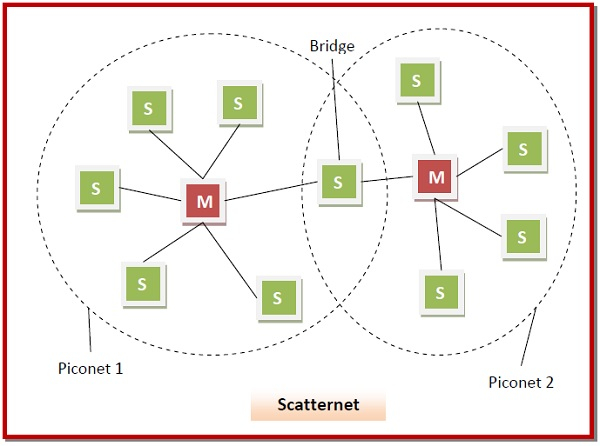
 Data Structure
Data Structure Networking
Networking RDBMS
RDBMS Operating System
Operating System Java
Java MS Excel
MS Excel iOS
iOS HTML
HTML CSS
CSS Android
Android Python
Python C Programming
C Programming C++
C++ C#
C# MongoDB
MongoDB MySQL
MySQL Javascript
Javascript PHP
PHP
- Selected Reading
- UPSC IAS Exams Notes
- Developer's Best Practices
- Questions and Answers
- Effective Resume Writing
- HR Interview Questions
- Computer Glossary
- Who is Who
Bluetooth Architecture
Bluetooth is a network technology that connects mobile devices wirelessly over a short range to form a personal area network (PAN). They use short-wavelength, ultra-high frequency (UHF) radio waves within the range 2.400 to 2.485 GHz, instead of RS-232 data cables of wired PANs.
There are two types of Bluetooth networks −
Piconets
Scatternets
Piconets
Piconets are small Bluetooth networks, formed by at most 8 stations, one of which is the master node and the rest slave nodes (maximum of 7 slaves). Master node is the primary station that manages the small network. The slave stations are secondary stations that are synchronized with the primary station.
Communication can take place between a master node and a slave node in either one-to-one or one-to-many manner. However, no direct communication takes place between slaves. Each station, whether master or slave, is associated with a 48-bit fixed device address.
Besides the seven active slaves, there can be up to 255 numbers of parked nodes. These are in a low power state for energy conservation. The only work that they can do is respond to a beacon frame for activation from the master node.
![]()
Scatternodes
A scatternet is an interconnected collection of two or more piconets. They are formed when a node in a piconet, whether a master or a slave, acts as a slave in another piconet. This node is called the bridge between the two piconets, which connects the individual piconets to form the scatternet.


